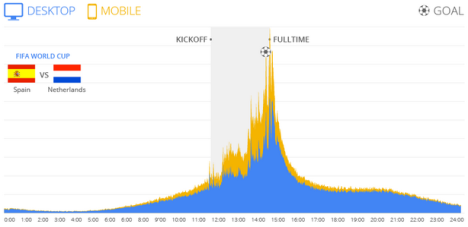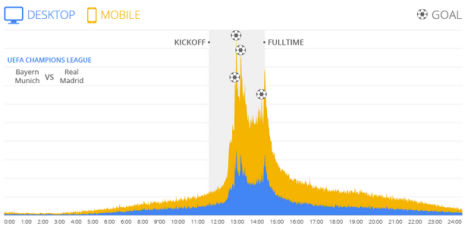How have football fans’ search habits changed since last World Cup?
 With constantly changing viewer habits Google’s Bart Jenniches looks at how fans are using search during games, and how marketers can capitalise.
With constantly changing viewer habits Google’s Bart Jenniches looks at how fans are using search during games, and how marketers can capitalise.
Soccer, according to Brazilian striker Pelé, is the beautiful game. It’s also the beautiful business, with the world’s biggest brands investing billions of dollars into the game every year.
The World Cup, which kicks off on June 13 here, is the single biggest marketing opportunity in the world, with almost one in two people in the world tuning in to watch. In the online world, the World Cup has more Google Searches than the Olympics, Superbowl and the Tour de France combined.With so many of the world’s eyes on the upcoming tournament, brands are once again beginning to jostle for their share of the action, with big budget TVCs and merchandising.
But there is one big change in how people will experience the World Cup this time round: Multiscreen.
During the 2010 World Cup, 18 per cent of global searches for games, players, and teams were done on mobile.
Mobile use is growing so fast, however, that four years have changed the picture completely. In a recent 2014 UEFA Champions League game, the proportion of searches on mobile was a whopping 63 per cent — an early indicator of what digital marketers are likely to see during this year’s World Cup.
This shift to mobile is really not surprising. According to GSMA, global smartphone penetration will have almost doubled between 2010 and 2014. Although the outright numbers are smaller, global tablet penetration will have grown even faster. By the end of this year, there will be one tablet for every five people on the planet.
But it’s not just the proportion of time that fans spend on mobile that is changing: their behaviour is too. The graph below, from the 2010 World Cup, shows that people mostly used their mobiles at the end of the game, to check on the score.
Searches For Games, Players and Teams: During 2010 World Cup Spain vs. Netherlands Match
Nowadays, as the graph below from a 2014 UEFA match shows, people are using second and third screens to search throughout the game to give them additional information on players, tactics and other information, especially at key moments such as goals.
Searches For Games, Players and Teams During 2014 UEFA Munich vs. Madrid Match
The growth in multiscreen use represents a huge opportunity for marketers to come up with creative executions.
For example, EA Sports is launching a campaign that will serve ads only to people within 3km of a football stadium, and only during the time a football game is actually being played. Different ads will be served depending on which stadium the fan is near, and which game is being played. It’s a straightforward banner execution, but the use of mobile makes it far more personal, relevant, and engaging.
Another good example comes from Coke, which is launching a special series of World Cup-themed mini-bottles in Brazil that, once scanned using a mobile phone, allow Brazilian and international fans to send each other messages.
The world’s leading advertisers have realised that mobile use is changing the way we market. Most companies are still playing catch-up — but the good news is the game isn’t over yet.
Curious marketers will be able to see Google Trends insights from every match throughout the tournament, including players to watch, and questions people are asking at google.com/worldcup (from June 9). So if for some reason the Socceroos don’t make the final, there is still plenty to check out.
Bart Jenniches is industry leader for consumer brands at Google Australia.





